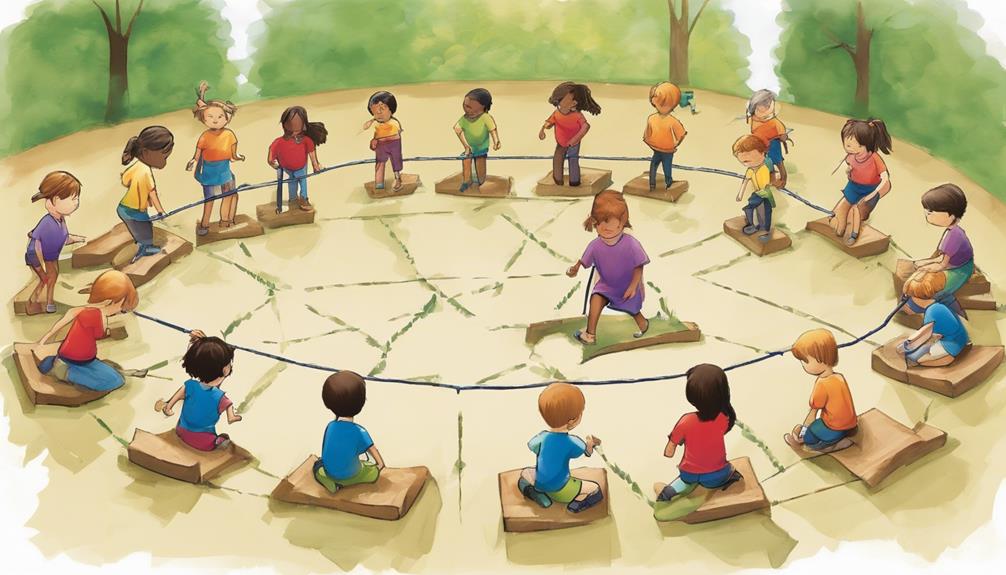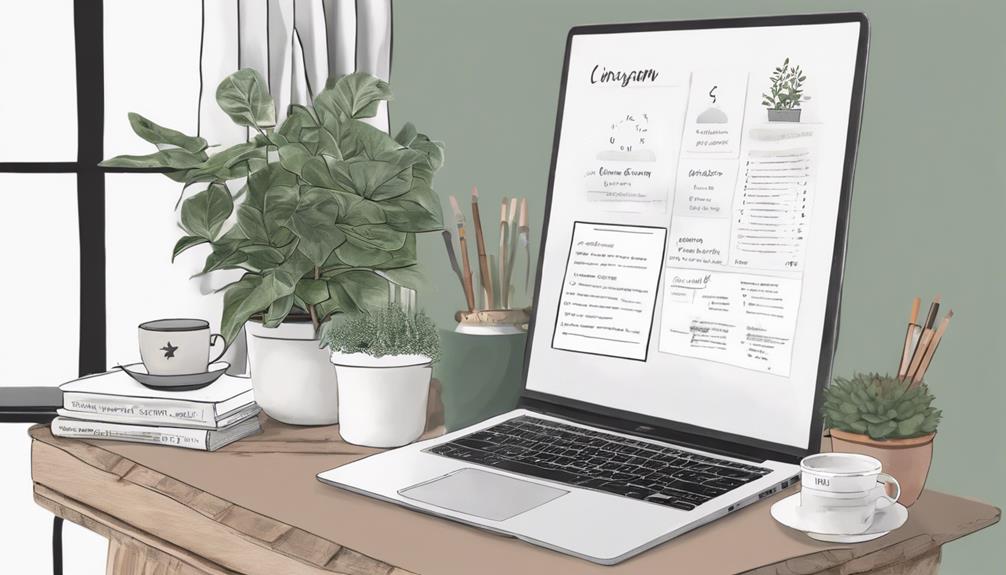As teachers, we recognize the significance of exposing children to advanced ideas in a manner that is captivating and suitable for their age.
While some may question the suitability of teaching personality types to kids, exploring the Enneagram can provide a valuable framework for self-discovery and understanding others.
Through a series of interactive and enjoyable activities, children can begin to unravel the intricacies of their personalities and those around them.
By incorporating Enneagram-inspired games, creative crafts, and outdoor adventures tailored to different types, young learners can embark on a journey of self-exploration that is both enlightening and enjoyable.
Key Takeaways
- Engage kids in dynamic games for insights into behaviors and emotions.
- Encourage creativity through craft activities for self-expression and self-discovery.
- Use interactive storytelling to help children connect with different personality traits.
- Foster self-awareness and personal growth through outdoor Enneagram activities and reflection journaling.
Engaging Enneagram Games for Kids
Have you ever wondered how engaging Enneagram games can help children discover their personality types in a fun and interactive way? Enneagram games for kids offer a dynamic approach to learning about different personality types through quizzes, activities, and discussions tailored to their level of understanding. By participating in these games, children not only gain insights into their own behaviors and emotions but also develop a deeper sense of self-awareness and empathy towards others.
These activities go beyond just identifying personality traits; they encourage children to reflect on how their unique characteristics influence their interactions and relationships with peers. Through exploring the Enneagram types in a playful setting, kids can grasp complex concepts related to social-emotional learning and enhance positive classroom dynamics. By engaging in Enneagram games, children aren't only having fun but also laying the foundation for a better understanding of themselves and those around them.
Creative Craft Activities for Children

Exploring Enneagram personality types through creative craft activities offers children a hands-on and engaging way to uncover their unique traits and foster self-discovery. These craft activities provide a platform for kids to delve into the intricacies of the Enneagram system while expressing themselves creatively. By engaging in art, storytelling, and various forms of creative expression, children can gain a deeper understanding of their own personalities and those of others. Crafting Enneagram-inspired items such as vision boards, affirmation cards, or character drawings can help children explore different facets of their identity and emotions, promoting self-discovery and emotional awareness.
| Craft Activity | Description |
|---|---|
| Vision Boards | Create visual representations of personal goals, dreams, and aspirations. |
| Affirmation Cards | Design cards with positive affirmations to boost self-esteem and confidence. |
| Character Drawings | Draw characters embodying different Enneagram personality types for insight. |
Engaging in these creative activities not only fosters exploration of personality types but also nurtures emotional intelligence and self-awareness in children, laying a foundation for personal growth and understanding.
Interactive Storytelling for Personality Exploration
Immerse children in captivating narratives that bring Enneagram personality types to life through interactive storytelling activities. Through these engaging activities, kids can explore the diverse traits and characteristics of each Enneagram type in a fun and educational way.
- Relatable Characters: Interactive storytelling introduces relatable characters that embody different Enneagram types, allowing children to connect with and understand the unique traits associated with each type.
- Empathy Development: By immersing themselves in stories that showcase various Enneagram types, kids can develop empathy towards others and gain a better understanding of different personality perspectives.
- Self-Discovery: Interactive storytelling activities provide a platform for children to reflect on their own traits and behaviors, leading to a better understanding of their own personality and how they relate to the Enneagram types.
Engaging in interactive storytelling not only sparks children's imagination but also nurtures their emotional intelligence and self-awareness as they explore the intricacies of personality exploration through these immersive narratives.
Fun Outdoor Enneagram Activities

Outdoor Enneagram activities provide a dynamic and immersive way for children to engage with their personalities through hands-on experiences tailored to each Enneagram type. These activities, such as nature walks and team-building exercises, offer students the opportunity to explore their unique personality types in a physical and mental way. By immersing themselves in outdoor environments, students can connect with their Enneagram traits on a deeper level, fostering self-awareness and personal growth.
Nature walks allow students to reflect on their individual characteristics while appreciating the beauty of the natural world. Team-building activities promote collaboration and understanding among different personality types, encouraging empathy and communication skills. Engaging in outdoor activities not only aligns with Enneagram principles but also provides a holistic approach to personality exploration.
Through community volunteer projects, students can further develop their social responsibility and empathy, reinforcing the values associated with their Enneagram types. Overall, outdoor Enneagram activities offer a fun and enriching way for children to discover and embrace their unique personalities in various settings.
Enneagram Reflection Journaling for Kids
In exploring the world of Enneagram Reflection Journaling for Kids, we invite young minds to embark on a journey of self-discovery and growth through the power of writing and reflection. This tool offers a unique opportunity for children to delve into their personality types, behaviors, and traits in a structured and meaningful way. Through reflection journaling, kids can enhance their self-awareness and emotional intelligence, gaining a deeper understanding of themselves and how they interact with the world around them.
Children can track their thoughts, feelings, and reactions to different situations, fostering a greater sense of self-understanding. By identifying patterns in their journal entries, kids can pinpoint their strengths, challenges, and areas for personal growth. Engaging in reflection journaling activities can support children in developing essential social-emotional skills, empowering them to navigate relationships and challenges with a heightened level of awareness.
Encouraging kids to reflect on their experiences through journaling can be a valuable tool in promoting self-discovery and personal development at a young age.
Frequently Asked Questions
How Can You Use the Knowledge of Your Enneagram Type to Help You in School?
Understanding our Enneagram type helps us tailor our learning approach and set realistic goals for academic success. It guides us in managing time effectively and identifying our strengths and areas for growth.
What Is the Most Playful Enneagram Type?
We think the most playful enneagram type is Type 7, known as 'The Enthusiast.' Characterized by spontaneity, optimism, and a love for adventure, Type 7 individuals are always seeking new experiences and fun opportunities.
Their playful nature brings joy, creativity, and excitement to any situation. They thrive on variety, avoiding routine and limitations, and infuse a sense of light-heartedness and energy wherever they go.
Is There an Enneagram Test for Children?
Yes, there's an Enneagram test specifically tailored for children. It's designed to be engaging and age-appropriate, helping kids explore their personality types in a fun and insightful way.
This test can assist children in gaining a better understanding of themselves, promoting self-awareness from a young age.
What Is the Most Difficult Enneagram Type to Get Along With?
We find Type 8, 'The Challenger,' to be the most challenging to connect with due to their assertiveness and need for control. Their directness and focus on power dynamics can create tensions in relationships. Understanding their motivations and boundaries is key to navigating interactions effectively.
Type 8 values honesty, loyalty, and authenticity, seeking mutual respect. Approaching them with openness and direct communication can foster better understanding and connections.
Conclusion
So, as you can see, incorporating Enneagram activities for kids is a fun and effective way to explore personality types and promote self-awareness.
While some may question the value of introducing complex theories to children, it's important to remember that these activities are designed to be engaging and age-appropriate.
By making learning about oneself and others enjoyable, we can help children develop important social and emotional skills that will benefit them throughout their lives.
Felicity, our Author, pens in-depth articles and guides that delve into the heart of personal discovery. Her narrative-driven approach weaves together theory, practice, and personal anecdotes, making the journey of self-exploration both relatable and inspiring. Felicity’s contributions help illuminate the path for those seeking a deeper understanding of themselves and their relationships.










